On the morning of Aug. 2, 1990, the US Air Force was a fighting organization of 535,000 active duty airmen. Some 106,000 of these troops were assigned to foreign air bases. Their chief mission was containing Soviet power, and virtually all of USAF’s attention was focused on Europe and the Far East.
Except for two tankers finishing up a training exercise in the United Arab Emirates, none of these overseas USAF forces were in the Persian Gulf region. The Air Force’s B-52 bombers sat nuclear alert at Strategic Air Command bases. Only a few fighters were equipped with precision weapons. And just about the only unmanned aircraft around were target drones.
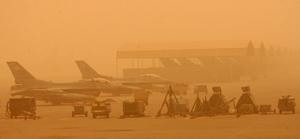 |
Air Force F-16CJ fighters in the Gulf, 2003. (USAF photo by SSgt. Matthew Hannen) |
Then Saddam Hussein’s Iraqi forces attacked and overran Kuwait. Within hours, the first Air Force fighters were racing to the Mideast to deter any further southward movement of the Iraqi divisions poised to threaten the Kingdom of Saudi Arabia.
No one would have guessed it at the time, but the international mission to deter Iraq and then rescue Kuwait was the beginning of the Air Force’s longest war. It has been fought in the skies over southern and northern Iraq, on the streets of Baghdad, in the border hamlets of Afghanistan, and at other little-noted global battle spots. After numerous force reductions, today’s Air Force comprises only about 323,000 airmen, most of whom have known little but fighting in the long war.
After 18 years, it is time to take stock. How has the Air Force adapted to this long war, and how well is it positioned for what lies ahead
Politically, the long war is about security after the collapse of the Cold War’s artificial bipolarity. Operationally, it’s been an airpower war from the outset. Airpower has taken the lead in every campaign, operated virtually alone for long stretches, and at all times has provided the architecture for employment of joint forces.
The first challenge was to find a way to prevail against entrenched Iraqi forces—the Desert Storm campaign. After American ground forces left the region, the remaining coalition partners relied on two no-fly zones to contain Iraqi forces, because Saddam did not comply with UN resolutions.
Next, the United Nations and NATO nations, respectively, authorized the use of stand-alone air campaigns as the principal military tools to halt Serb-led “ethnic cleansing” actions in Bosnia in 1995 and Kosovo in 1999.
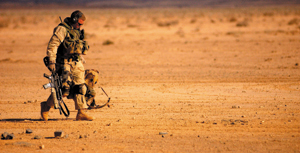 |
Battlefield airman in Iraq, 2004. (USAF photo by SSgt. Jeremy T. Lock) |
The Sept. 11, 2001 terrorist attacks in the United States sparked direct military action against Taliban-controlled Afghanistan, which had become a safe harbor for the al Qaeda terrorist organization. Washington again assembled and led a coalition to unseat the Taliban government and, on Oct. 7, 2001, launched Operation Enduring Freedom.
In March 2003, a smaller US-led coalition invaded Iraq to wipe out the perceived threat posed by Saddam to Americans and their allies. The unknowns were great in a country where Saddam had blatantly defied no-fly zones and UN weapons inspectors who had for years attempted to enforce the terms of the 1991 cease-fire agreement.
Across the Middle East, the task after major combat operations ended in early 2003 was to bring stability to regions stuffed with arms and hostility. Iraq became a battleground over civil authority and the site of a duel between al Qaeda and the US-led coalition.
Moreover, the US and NATO have in the past year stepped up their activity in Afghanistan in an effort to bolster and rebuild the country and deny any new safe havens for resurgent terror organizations.
For airmen, the long war will not be ending anytime soon. Under any conceivable troop plan for Iraq, for example, USAF will still have critical continuing missions. Airmen will provide intelligence-surveillance-reconnaissance capabilities, keep major aerial ports running, and continue training Iraqi air forces. USAF will probably provide some degree of on-call air support for some time.
The Air Force has constantly changed and adapted to provide the kinds of sophisticated capabilities needed for the long war. In the process, this combat-hardened organization has become an Air Force unlike any other.
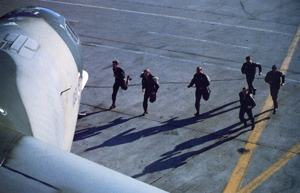 |
|
Expeditionary Now
The Cold War force garrisoned at large US, European, and Asian bases is now an expeditionary force whose members know packing up and setting up as a way of life. Secure networks run all operations and logistics. Female airmen serve in nearly every combat specialty, from security forces to bomber crews. The Total Force of active, Guard, and Reserve is integrated more tightly than ever.
While the changes wrought by the long war range from the epic to the personal, there are six that stand out. They are best summed up with the words precision, nonlinear battlespace, cyberspace, unmanned air systems, ISR fusion, and cooperative targeting.
Each of the six can be found at the core of operations today—but they were barely on the horizon in 1990, at the start of the long war. All are having a profound impact on the current Air Force and its role in joint operations and will continue to do so well into the future.
The six concepts are not static. They got their start in the early 1990s. However, the upswing in activity in Iraq and Afghanistan since 2005 has led to their being intertwined with new tactics and initiatives.
Precision. Laser guided weapons debuted in Vietnam and won popular acclaim in the 1991 Gulf War, yet USAF sent into battle in Desert Storm only about 150 fighters that could self-designate laser guided bombs.
Technological improvements have accelerated, and the Air Force now fields an enormously powerful and versatile precision force.
In 2003, USAF fighters in theater had the ability to employ precision weapons with laser or GPS satellite guidance. Most important, the ubiquitous Joint Direct Attack Munition was a combat-proven asset. B-52s and B-1s often carried a mix of weapons to give air controllers a choice.
After its debut in 2004, the new 500-pound JDAM became the weapon of choice to support ground forces fighting in Iraq’s urban areas.
The precision revolution did not stop with strike. In the field of mobility, the Joint Precision Airdrop System debuted in Afghanistan in 2006. JPADS combined a steerable pallet with GPS aiming. The system—a joint effort between the Army and the Air Force—allowed aircraft to drop cargo more accurately, from much higher altitudes, and at greater speeds.
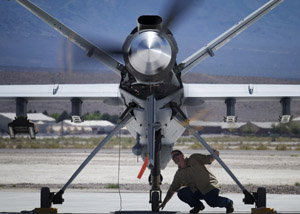 |
The MQ-9 Reaper, deadliest of the UAVs, 2008. |
After August 2006, the wars saw a surge of precision airdrops staged in support of coalition and special operations forces in Afghanistan. In February 2007, JPADS made its first combat drop in Iraq with improved software. This product of the long war opens up new possibilities for deploying forces with a lighter footprint and for conducting relief supply missions in more places.
Nonlinear battlespace. The June 1996 attack on the Air Force’s Khobar Towers housing complex in Saudi Arabia showed that rear areas were no longer safe havens. The Air Force does not necessarily operate from secure, garrisoned bases well behind the front lines. During the 2003 invasion of Iraq, for example, fighters and helicopters moved north into Iraqi airfields almost as soon as they were captured.
Of equal consequence, the Air Force and Army agreed in 2005 to change the division of labor so that the Air Force is responsible for defending its own overseas air bases. Take the example of Balad AB, Iraq. During certain periods, mortar attacks were frequent. Mess halls, cargo facilities, even ramps and taxiways presented tempting presurveyed targets.
The perimeter at Bagram Air Base in Afghanistan was a problem from the start, and saw terrorist attacks at or near the front gates. Air Force security forces have gone on the offense to keep the perimeter and gate secure.
Training to Survive
The fact that any airman may be in harm’s way led to an increase in expeditionary combat skills that begins now in basic training. Fitness, firing weapons, and small unit discipline are recognized as essential qualities for every airman in an emergency situation. The combat training of those so-called “in lieu of” airmen on loan to the Army to drive convoys underscores this transition.
The long war has shown that deployment of airmen to unpredictable and unsettled locations is a given. The Air Force is planning to train more security forces for specialized expeditionary combat skills and is procuring everything from mine-resistant vehicles to new handguns and body armor for the nonlinear battlefield.
All of this is intended to increase the individual airman’s chances of surviving conventional attacks on the ground, in so-called “outside-the-wire” missions. Long term, the Air Force goal is to open and operate from air bases of its own choosing, in a high- or low-threat area.
Cyberspace. China may be seen as this nation’s top potential adversary in the realm of cyberspace—but it actually was the working conditions of the long war that highlighted cyberspace as a vital and distinct domain.
In 1991, computer-aided force planning and management was in its infancy. Now, online chat is the backbone of tactical operations, and cyberspace stores and transmits the Air Force’s most critical information.
The dependence on cyberspace systems permeates operations in Afghanistan and Iraq. Vast amounts of information and communications are quickly transmitted worldwide, and must be done so securely.
Against that background, the Air Force drew cyberspace into its mission statement in 2005. This philosophical shift elevated the cyber realm to be on par with the Air Force’s traditional operating domains of air and space.
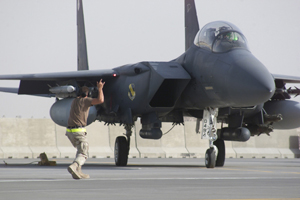 |
F-15E fighter at a Southwest Asia base, 2003. |
In 2007, the service established its provisional Air Force Cyber Command. The birth of AFCYBER took place amidst a longer-term effort to shift funding to the new command and to infuse it with the right personnel on the right career paths.
The Air Force is now on the cusp of routinely presenting cyber-attack capabilities to joint force commanders as options to “strike” theater targets. It is a new form of precision, with immense implications. Looking back, the embrace of cyberspace may stand as one of the most significant products of the long war.
Unmanned air systems. The MQ-1 Predator and the newer, more capable MQ-9 Reaper are the darlings of the long war.
It is safe to say that none of these new medium- and high-altitude UAVs were even a glint in the eye of top generals during the Cold War. Despite years of experiments and research, it took most of the 1990s for the Air Force to develop Predator into a capable platform.
The high-altitude Global Hawk emerged from the 1990s to play a dominating reconnaissance role in Afghanistan in 2001 and Iraq in 2003—while still formally listed as a test program.
The fact that unmanned systems have become a hotly disputed roles and missions issue attests to how important the unmanned revolution really is. The hours flown in the long war have convinced all of the utility of unmanned systems, as well as their reliability—at least in benign airspace.
The Air Force is fully committed to UAVs and has redoubled crew production, accelerated acquisition, and stood up new units for the mission. The 42nd Attack Squadron, which operates Reapers flying over the CENTCOM region from its home base at Creech AFB, Nev., is the Air Force’s first unmanned attack squadron. The “attack” designation signifies how far beyond ISR unmanned aircraft have moved.
Autonomous air refueling is being pursued in large part to extend the already-impressive endurance of unmanned vehicles.
UAVs have been normalized within the Air Force. They are part of the Total Force; leaders make efforts to ensure their crews have a normalized career path; upgrades and spirals continue improvements in effectiveness.
Yet the future of unmanned forces will require effective Air Force stewardship to ensure the force of tomorrow continues to improve and meet evolving requirements.
Predators and Reapers operate today in benign airspace. Future UAV missions may have to contend with hostile and defended airspace, which would put today’s fragile platforms in danger.
ISR fusion. It is difficult to assign a term to the revolutionary fusion of intelligence-surveillance-reconnaissance products that now constitute daily fare in air operations centers.
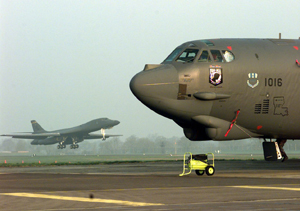 |
Kosovo-bound B-52 (front) and B-1B in Britain, 1999. |
Even Adm. Michael G. Mullen, Chairman of the Joint Chiefs of Staff, struggled to describe the impact of the “whole ISR piece” on current operations.
What’s clear is that USAF has been at the core of a series of revolutions in the ability to fuse ISR into a powerful weapon. The War on Terror’s demand for uninterrupted tracking of individuals, such as terrorist ringleaders, led to rapid fusion of numerous information sources. Never before have airmen been able to produce a comparable real-time product for commanders.
A suite of products and tactics is responsible. Full-motion video provided by Predator is perhaps the best-known example, but there are many more.
The E-8 Joint STARS aircraft’s ground moving target indicator radar has been used to rerun insurgent movements and track targets.
Global Hawk imagery, shipped by satellite, has been used in real time to verify targets.
A fusion of numerous “national” sources—including signals intelligence—is routinely used to locate top terrorists and set up lethal strikes. Almost none of this was possible in 1991.
The fusion provides commanders such a powerful tool that none will deploy or operate without this ISR picture in the future.
The Distributed Common Ground Station merges signals and imagery intelligence from many sources into a working picture of the battlespace. Based on an open architecture, the DCGS enables intelligence professionals to manage and task information flow from dedicated sites. It’s an integration capability far superior to anything available before the start of the long war.
Cooperative targeting. The long war has seen a series of revolutions in the way USAF provides close air support for soldiers, marines, and commandos. Insurgent and urban battles have honed air and ground cooperation like never before.
The wake-up call was Operation Anaconda in Afghanistan in March 2002. Airmen delivered copious air strikes to support US troops trapped in the Shah-i-Kot mountains, but all agreed the coordination systems were overwhelmed.
Coordination improved with use of a detailed keypad grid and close air support stacks over Iraq in 2003. Since then, the air component has often been the ground soldier’s watchdog, literally following patrols to provide ISR or air attack as needed. The laptop-based ROVER (Remote Operations Video Enhanced Receiver) system allows airmen and ground controllers to share a real-time video picture of a target they are tracking. This allows for stunning efficiency: An F-16’s infrared sensor pods recently directed a foot patrol to within a meter of an individual hiding in brush.
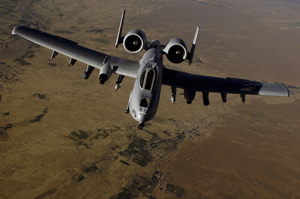 |
|
Gains like this have occurred before, of course. Air-ground cooperation was honed to a fine edge in World War II, only to decay afterward. The shortcomings were vivid just five years later in Korea, where lessons had to be learned all over again, under fire.
But today’s strategy hinges on air-ground integration. Effective backing of deployed US ground forces, the Iraqi Army, and other allies around the world is a key to reducing and repositioning US ground forces overseas. This requires US airpower.
The key question for the Air Force is whether it will be able to reap the full benefits of the lessons of the long war.
For all the transformation that’s taken place, there is still a lengthy to-do list coming straight from combat experience. On the list just for existing aircraft are a string of modifications such as beyond-line-of-sight links and communications for all aircraft; a single data link for joint and coalition aircrews; positive identification capability for all aircraft; better electronic attack; protection optimized for modern air-to-air and air-to-ground threats; and infrared self-protection.
In the Background Now
Improving weaponry is important, too. Top needs include more flexible fuses, weapons that can withstand GPS or laser denial, and modular and upgradable seekers.
One of the greatest unknowns is whether the Air Force has the backing to bridge from the long war to the next war.
The long war has not moved air, space, or cyberspace to the center of the nation’s thinking about national defense. Almost the reverse has happened. The eye-catching air strikes of the 1991 Gulf War gave way to air operations conducted in the background.
The no-fly zones and occasional strike operations of the 1990s were fleeting headlines.
Today’s continuous combat air patrols providing surveillance and firepower over ground forces in Afghanistan and Iraq are scarcely noticed.
Even more obscure are the thousands of sorties flown for Operation Noble Eagle to defend the US against another 9/11 scenario.
Simultaneously, USAF’s top leadership has had many bruising encounters during the long war. The Air Force saw three of its Chiefs of Staff retire early—in 1990, 1997, and 2008.
The resignation of Gen. T. Michael Moseley, who led coalition air forces over Afghanistan and during the invasion of Iraq, was accompanied by the resignation of Secretary of the Air Force Michael W. Wynne. This was a historic decapitation ordered by Defense Secretary Robert M. Gates. Each of these incidents over the past 18 years had a common element: Pentagon leadership was at odds with the Air Force.
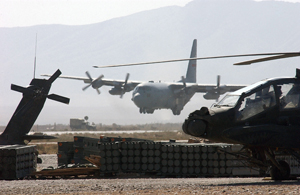 |
|
Serious questions linger about the ability of the Air Force to come out the other side of the long war with a modernized, effective force.
It will be difficult to capitalize on the many tactical lessons of the long war while dragging along an old and increasingly decrepit force structure. The long war has sucked recapitalization accounts dry while piling up more debt in the form of extra wear and tear.
Older aircraft are most immediately affected, but it’s the grind on relatively new platforms such as the C-17 that may be most problematic in the long run.
Nor is it clear that USAF will emerge from the long war with its roles and missions intact. The proper wartime distribution and control of unmanned aircraft is far from settled, but Air Force initiatives to take charge have twice been smacked down.
The Army is dramatically increasing its battlefield lift business with the Joint Cargo Aircraft, encroaching on one of USAF’s key missions.
Cyberspace leadership is still undefined, and USAF’s efforts to take the lead could create conflict with the other services and government agencies with stakes in the cyber mission.
The Pentagon’s unwillingness to fund USAF’s required number of new fighters seems designed to push the service toward even more of a supporting role.
For airmen, the biggest question does not concern whether the Air Force can succeed in the long war. The real question is how USAF can best defend US interests in the face of inadequate budgets and flagging influence. The Air Force must somehow keep investing in victory for tomorrow as well as today, but it can’t do that all by itself.
Rebecca Grant is a contributing editor of Air Force Magazine. She is president of IRIS Independent Research in Washington, D.C., and has worked for RAND, the Secretary of the Air Force, and the Chief of Staff of the Air Force. Her most recent article for Air Force Magazine, “The Big B,” appeared in the July issue.